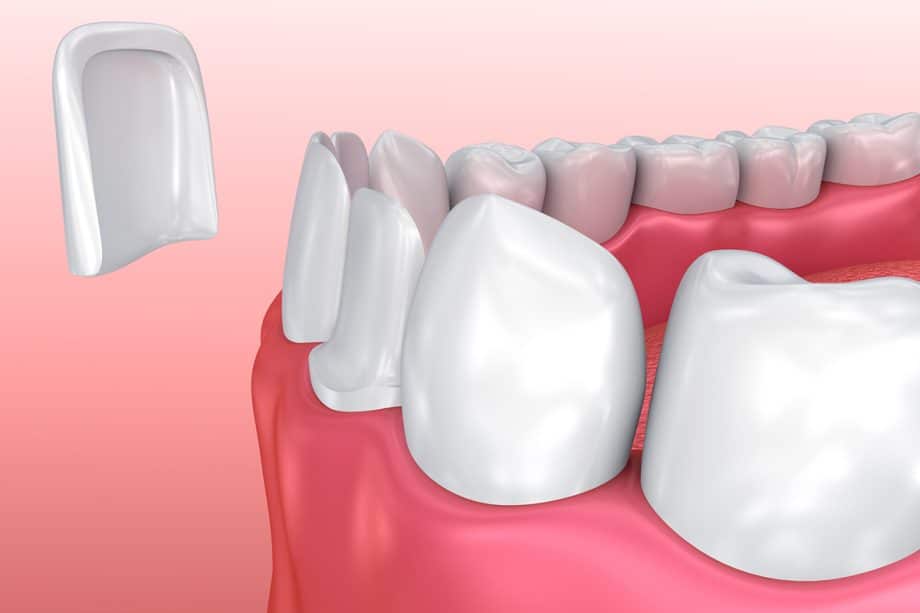You may have heard of dental veneers as a form of cosmetic dentistry that can rejuvenate your smile, but what you may not realize is that there are different types of veneers. The material the veneer is made from is either porcelain or composite, and each has benefits and considerations to keep in mind as you decide which solution is right for your smile.
What Are Composite Veneers?
Where does the name “veneer” come from and why is this procedure called that? The term “veneer” means to face or cover an object with a coating of another material to form a new surface. When a patient elects to get dental veneers, a thin layer of enamel is removed from one or more teeth, and then a thin covering, or veneer, is applied over the original surface of the teeth to improve the aesthetics of a smile. The material that covers the teeth can be made of either porcelain or composite and is held in place with a physical bond to the enamel of the original teeth. This process is known as “bonding.”
What Are the Benefits of Composite Veneers?
Both composite and porcelain veneers are a great option for patients who have stained, chipped and worn teeth. For patients who may feel their teeth are too small or short, veneers can be used to lengthen the teeth as well as close spaces and fill in gaps between teeth. Full smile makeovers, which usually involve 8-10 teeth, can be quite dramatic and can boost both the patient’s confidence and the aesthetics of their smile .
Why Are Composite Veneers so Popular?
Composite veneers are not new, but they have become a preferred dental procedure choice for patients considering dental veneers. Their recent rise in popularity is likely attributed to two major factors in comparison to porcelain veneers:
- Composite veneers are more conservative than porcelain veneers.
- Composite veneers are less expensive than porcelain veneers.
What Does ’More Conservative’ Mean?
Composite veneers are mostly an additive procedure, meaning that generally less enamel – or sometimes none at all – needs to be removed from the surface of the existing teeth versus that which is needed for porcelain veneers. Often, if the teeth are already in the correct orthodontic position, the surface just needs to be prepared using air abrasion, which uses pressured air and tiny particles in a minimally invasive approach that is only slightly more abrasive than a typical dental cleaning.
Why Are Composite Veneers Less Expensive?
Porcelain veneers are custom-made in a dental laboratory, but composite veneers are fabricated, sculpted and applied directly onto the teeth by the dentist during the procedure. In some cases, composite veneers can even be completed in one sitting. Since the procedure does not involve the use of a dental lab, patients can save by eliminating lab costs.
What Are the Drawbacks of Composite Veneers?
Although composite veneers can transform your smile with a beautiful and natural appearance, they are created using somewhat of an artform. They are crafted using a skilled technique, wherein the dentist creates a restoration that requires different layers of composite colors and translucency. Advanced training and knowledge on how to use these materials is imperative in creating a restoration that is similar to the aesthetics of a porcelain veneer.
Additionally, composite veneers are not as durable as porcelain veneers. Because the material is not as strong, composite veneers can chip or fracture. As a result, composite restoration has a shorter lifespan than porcelain veneers, which are known to last for 10 years or more.
What Is the Difference Between Bonding and Composite Veneers?
When resin is mechanically attached to the enamel of a tooth, or sometimes the layer just underneath called dentin, this procedure is commonly referred to as bonding. Typical bonding uses composite material to repair worn or chipped edges, fill cavities and address other minor cosmetic situations. While both procedures do use a composite material, one of the primary differences lies in their application. By contrast, composite veneers cover or veneer the entire exterior of the tooth, from edge to edge and top to bottom giving the tooth an entirely new surface, whereas bonding is typically best suited for smaller restorations.
Learn More About Composite Veneers
If you’re ready to learn more about whether composite veneers are right for you, the team at Glassman Dental Care is here to help you achieve your smile goals. Contact us today at 212-787-4860 or request an appointment online and we’ll get you on your way to loving your smile once again.

